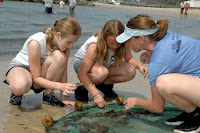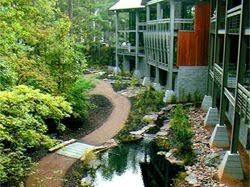 RALEIGH – The Office of Environmental Education today released the plan that serves as the state’s guiding document for environmental education efforts.
RALEIGH – The Office of Environmental Education today released the plan that serves as the state’s guiding document for environmental education efforts.The North Carolina Plan for Environmental Education outlines strategies for increasing environmental literacy and natural resource stewardship in North Carolina.
There has been a recent surge of interest in environmental literacy, especially on the federal level. The Partnership for 21st Century Skills now recognizes environmental literacy as one of the five interdisciplinary themes essential to student success. Moreover, environmental literacy was recently included in the President’s 2010 education budget, and federal legislation has been proposed that would provide states with funding for teachers’ professional development and programming in environmental education through the No Child Left Inside Act.
“Environmental education has a long history in North Carolina, and the renewed focus on increasing environmental literacy makes this a very exciting time for our state,” said Lisa Tolley, director for the Office of Environmental Education.
The goal of environmental education is increased environmental literacy, but there are many benefits to being outside and engaged with the natural environment. Environmental education also fosters an environmental ethic and encourages civic responsibility while promoting healthy, active lifestyles.
Although the previous plans performed extremely well as a guiding framework for the office and other environmental educators in North Carolina, many of the original goals have been accomplished. Demographic and economic changes in the state, advances in the environmental education field and technological innovations necessitated an updated plan.
Members of the N.C. Environmental Education Advisory Council, a volunteer body comprised of representatives from the academic, business, economic development and environmental communities, were crucial in drafting the third edition of the plan. While the third edition retains the core goals and definition of environmental education reflected in previous plans, it is enhanced by the perspectives and ideas of a broader selection of academic, environmental, cultural arts, business and agricultural contributors. The result is an effective guidebook for environmental education in the 21st century.
“This is a pivotal time for environmental education in our country,” said Dee Freeman, secretary for the N.C. Department of Environment and Natural Resources. “Citizens will be required to address and solve complex environmental issues affecting the economy, public health and shared natural resources. I think this plan will help bring our state closer to its goals for environmental literacy.”
The plan is available online at http://www.eenorthcarolina.org/ee_plan_web_spread.pdf (low resolution print version http://www.eenorthcarolina.org/ee_plan_web_print.pdf. You can view members of the N.C. Environmental Education Advisory Council at http://www.eenorthcarolina.org/eeadvisorycouncil.htm.
Media Contact: Lisa Tolley, director 919-733-0711




